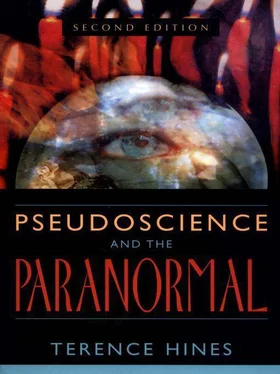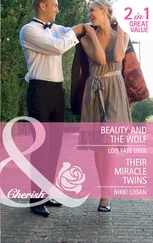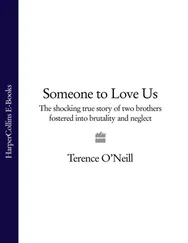In all of these examples, phenomena that were initially considered to be pseudoscientific and unworthy of study have been shown to have some basis. These cases alone would justify the study of other pseudoscientific and paranormal phenomena, although it must be realized that the “hit rate” in this type of endeavor is very low. Of the numerous paranormal claims considered in the remainder of this book, the vast majority will be found to have no scientific support.
Responsibility to Inform the Public about the Truth of Paranormal Claims
A glance at the occult books section in any moderately large bookstore is all that is needed to convince one of the huge market for pseudoscientific and paranormal claims in this country. A 1997 poll (Nisbet 1998) found that 45 percent of Americans believe in faith healing, 30 percent in UFOs, 37 percent in astrology, and 25 percent in reincarnation, to give a few results. John Mack’s (1997) book Abduction: Human Encounters with Aliens was a best-seller when it was published. Every kind of pseudoscientific claim finds eager buyers. Psychics, palm readers, tarot card readers, mediums, and the like rarely lack for victims willing to shell out fifteen, twenty-five, or even one thousand dollars for a reading. Those who claim that Earth was visited in historical times by ancient astronauts, or that there is a mysterious area off Florida’s east coast where ships and planes have disappeared, or that they can bend keys with sheer mind power can make millions from books, films, and the lecture circuit. In short, the public spends a lot of time and money supporting the proponents of pseudoscience and the paranormal. As will be seen in the following chapters, there is not one bit of evidence to support these pseudoscientific claims, and much evidence exists that flatly contradicts them. This being the case, the continued claims by proponents of pseudoscience constitute nothing short of consumer fraud. And it is a massive fraud that costs the American public billions of dollars each year. In this situation, scientists have a strong responsibility to investigate pseudoscientific claims and to speak out vigorously when those claims are shown to be false. Unfortunately, communication of the real data on the truth of pseudoscientific claims is often hampered by the media. Television and radio programs and newspapers are frequently more interested in presenting sensational claims than in carefully evaluating the truth of such claims. The media, both print and electronic, have often acted with extreme irresponsibility in covering pseudoscience and the paranormal. In the case of uncritical coverage of faith healers and psychic surgeons, this lack of responsibility on the part of the media has resulted in injury and death.
The case for speaking out is even clearer in the case of modern health and nutrition quackery, now known as “alternative medicine,” which in the early 1980s was a $10-billion-a-year problem in the United States (Pepper 1984). The figure must be much higher now. The quacks’ and charlatans’ victims are most likely to be those least able to defend themselves—the desperate, the elderly, and the poor.
Only through careful evaluation of pseudoscientific claims and seeing that the results of those evaluations are reported by the popular media can the public be fully informed. The proponents of pseudoscience and the paranormal, who make vast sums of money selling their wares, are unlikely to provide the public with accurate information. Scientists, then, have a responsibility to inform the public.
Ethical issues aside, several important psychological issues are raised by the study of pseudoscience and the paranormal and people’s belief in them. The major issue is why people come to believe in such claims in the first place. What is it that convinces them, for example, that astrology is a valid method to guide their lives? Or that biorhythms really predict when they are most likely to do well or poorly on an exam? Second, why do these beliefs persist so strongly in the face of clearly contradictory evidence?
The answers to these questions will be discussed throughout the remainder of this book. Suffice it to say here that research on perception, and especially memory, has demonstrated the importance of cognitive illusions that are in many ways analogous to visual illusions. These cognitive illusions provide the basis for both initial and continued belief in pseudoscientific and paranormal claims, although other factors to be discussed are also important. Dawes (2001), Shermer (1997), and Vyse (1997) have all written book-length treatments of the psychology of belief that go into much greater detail than I am able to here. Lastly, the widespread acceptance of paranormal and pseudoscientific belief raises important sociological questions. Although these are beyond the scope of this book, Goode (2000) has discussed them in detail.
Dangers of Paranormal Beliefs
Skeptics are often asked, “Who cares if there really isn’t anything to astrology? What does it hurt if someone believes in it?” I’ve found that this question is frequently asked by proponents of pseudoscientific claims when they have been backed into a corner by the evidence. The answer can be made at three levels. At a philosophical level, most people would agree that it is harmful to hold invalid beliefs and that, generally speaking, one should base one’s life on a correct view of how the world operates. To do otherwise is to be deluded.
On a more practical and personal level, one can consider pseudoscientific and paranormal claims in the context of consumer fraud. People are being induced through false claims to spend their money—often large sums—on paranormal claims that do not deliver what they promise. Presumably no one would ask, “What’s the harm if the label says the cereal box contains sixteen ounces but it really only contains thirteen ounces?” The situation is the same for paranormal claims, except that the box is empty. The personal damage done by uncritical acceptance of paranormal claims can be most clearly seen in faith healing and psychic surgery (see chapter 10), and alternative medicine (see chapter 11). People go to these fraudulent healers and often are convinced, incorrectly, that they have been cured. Thus, they may not seek legitimate medical help. By the time they realize that they have not, in fact, been cured, they may be beyond even medical help. Nolen (1974) has documented such cases. Of all the proponents of pseudoscience, faith healers and psychic surgeons are the most dangerous—they kill people.
Finally, from the point of view of society at large, uncritical acceptance of paranormal belief systems can be extremely damaging. The classic example is the witchcraft craze that swept Europe between approximately the middle of the fourteenth and the beginning of the eighteenth centuries. During that period, well over two hundred thousand people were burned, tortured, or hanged as witches (Robbins 1959). The belief in the reality of witches is a classic example of a paranormal belief. It shares many characteristics with modern-day paranormal belief systems. We will see, for example, in chapters 7 and 8 that proponents of the reality of UFOs as extraterrestrial spacecraft argue that some of the strongest evidence for the reality of UFOs is the many reports of UFOs that have been seen and reported by reliable, trained, sane observers. Yet even a short perusal of the literature on witchcraft will reveal hundreds of similar reports of witches turned in by reliable, trustworthy witnesses. Of course, not one of these reports was true.
Another similarity between the belief in witchcraft and the belief in numerous modern pseudoscientific claims is the presence of an irrefutable hypothesis as a cornerstone of the belief system. For the poor individual accused of being a witch, the irrefutable hypothesis spelled a slow and lingering death. There was no possible piece of evidence that could show that the accused was not a witch. Once an accusation was made, no matter how flimsy the grounds for it, the accused was arrested. At this point, the accused was asked to confess to the charges. If the confession was not made, the accused was tortured. If a confession was still not made, the torture continued. Johannes Junius, the burgomaster of Bamberg, made this point in his last letter to his daughter before he was executed as a witch in August 1628. He described the several days of torture he endured without confessing and then says, “When at last the executioner led me back into the cell, he said to me, ‘Sir, I beg you, confess something, whether it be true or not. Invent something, for you cannot endure the torture which you will be put to; and even if you bear it all, yet you will not escape, not even if you were an earl, but one torture will follow another until you say you are a witch’” (Robbins 1959, pp. 292–93). There was no way out. If one confessed without torture to being a witch, one was executed. If one did not confess at once, one was tortured until one did—and was then executed. If one confessed and later recanted the confession, the torture started anew. To make matters worse for the accused, who might be willing to confess at once simply to escape torture, one was asked to name acquaintances who had engaged in witchcraft. If names were not forthcoming, they were extracted, again, under torture. These other individuals were then rounded up and tortured into confessing and naming, still more “witches,” and so the horrible cycle went on.
Читать дальше












